| This article needs additional citations for verification. Please help improve this article by adding citations to reliable sources. Unsourced material may be challenged and removed. Find sources: "Culture of Nepal" – news · newspapers · books · scholar · JSTOR (December 2007) (Learn how and when to remove this message) |
| This article is part of a series on the |
| Culture of Nepal |
|---|
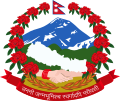 |
| Society |
| Arts and literature |
| Other |
| Symbols |
|
|
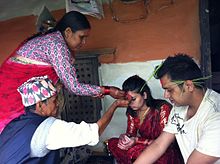
The culture of Nepal encompasses the various cultures belonging to the 125 distinct ethnic groups present in Nepal. The culture of Nepal is expressed through music and dance; art and craft; folklore; languages and literature; philosophy and religion; festivals and celebration; foods and drinks.
Dance and music
Main articles: Music of Nepal and Dance in Nepal
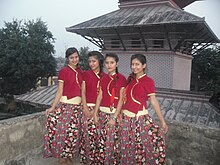
Legends state that dances in this country originated in the abode of Lord Shiva — the Himalayas, where he performed the tandava dance. This indicates that dance traditions of Nepal are very ancient and unique. With altitudes and ethnicity, the dances of Nepal slightly change in style as well as in the costumes. The Dishka, a dance performed at weddings, includes intricate footwork and arm movements. Accompanying music and musical instruments change in tune with the themes, which revolve around topics like harvesting of crops, marriage rites, war stories,love, and several other themes and stories from everyday life in the villages. The Tharu stick dances and the peacock dance are also performed.
Languages
Main article: Languages of NepalAs many as 123 languages are spoken in Nepal according to the 2011 census. Most of them belong to either the Indo-Aryan or the Tibeto-Burman language families. The major languages of the country (percent spoken as mother tongue) are Nepali (44.6%), Maithili (11.7%), Bhojpuri(6%), Tharu (5.8%), Tamang (5.1%), Nepal Bhasa (3.2%), Magar (3%) and Bajjika (3%), and Doteli (3%).
Nepali, written in Devanagari script, is the official national language and serves as lingua franca among Nepalese ethnolinguistic groups.
Religions and philosophy
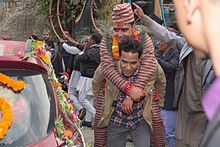
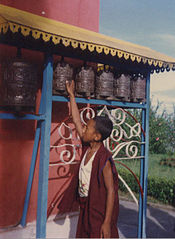
The 2011 census identified 81.6% of the population being Hindu. Buddhism was practiced by about 9% of the population. About 4.2% practice Islam and 3.6% follow the indigenous Kirant religion. Christianity is practiced officially by less than 1.0% of the population.
Hindu and Buddhist traditions in Nepal go back more than two millennia. In Lumbini, Buddha was born, and Pashupatinath temple, Kathmandu, is an old and famous Shiva temple of Hindus. Nepal has several other temples and Buddhist monasteries, as well as places of worship of other religious groups. Traditionally, Nepalese philosophical thoughts are ingrained with the Hindu and Buddhist philosophical ethos and traditions, which include elements of Kashmir Shaivism, Nyingma school of Tibetan Buddhism, works of Karmacharyas of Bhaktapur, and tantric traditions. Tantric traditions are deep-rooted in Nepal, including the practice of animal sacrifices. Five types of animals, always male, are considered acceptable for sacrifice: water buffalo, goats, sheep, chickens, and ducks. Cows are very sacred animals and are never considered acceptable for sacrifice .
Festivals and celebrations
Main article: List of festivals in Nepal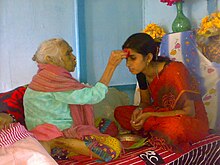

Several of the festivals of Nepal last from one to several days. As a predominantly Hindu and Buddhist nation, most of the Nepalese festivals are religious ones. The festivals of Nepal have their roots in Hinduism as more than 80% of the population of the country is Hindu. Buddhism, the second-largest religion of the nation which accounts for 9% of the population, has influenced the cultural festivals of Nepal. Dashain or Vijaya Dashami is the longest and the most important festival of Nepal. Generally, Dashain falls in late September to mid-October, right after the end of the monsoon season. It is "a day of Victory over Demons". The Newars celebrate the festival as Mohani, Tihar or Dipawali, Holi, Saraswati Puja, Rakshabandhan, Janmashtami, Gai Jatra, Nag Panchami, Teej, Chhath, Kartik Poornima, Maghe Sankranti, or Makar Sankranti, Maha Shivratri and Chhechu are widely celebrated important festivals of Nepal. New Year's Day of the lunar calendar Nepal Sambat occurs in November. Several Jatras take place throughout the year and public holidays are declared in some regions.
Other important festivals include Buddha Purnima (the celebration of the birth of Buddha) Maha Shivaratri (a festival of Lord Shiva) and during Maha Shivaratri festivities, some people consume excessive drinks and smoke charas. Sherpas, mostly located at higher altitudes and in the Mount Everest region, celebrate Mani Rimdu, for the good of the world.
Most festivals include dancing and music, and a variety of special foods are consumed during festivals and on special occasions.
The Sagan ceremony is the ritualized presentation of five food items (boiled egg, smoked fish, meat, lentil cake and rice wine) to a person which is done to bring good fortune as per Tantric tradition.
Architecture and archaeology
Main article: Architecture of Nepal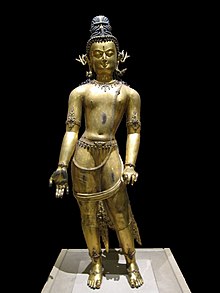

Nepal Sampada Sangha (Nepal Heritage Society) has compiled an inventory of 1,262 significant architectural and archeological sites in Nepal outside Kathmandu Valley.
Sports
The government declared volleyball as the national game of the country. Before it used to be dandi biyo.
A Cabinet meeting held at the Prime Minister Pushpa Kamal Dahal's residence in Baluwatar took the decision. The Ministry of Youth and Sports had put the proposal to declare volleyball as the national game. Nepal Volleyball Association had been demanding that the sport, which is played in all 75 districts of the country, should be the national game.
National Sports Council's former Member Secretary Yubaraj Lama had initiated the process of deciding the national game, while the current Member Secretary Keshab Kumar Bista had recommended for the national game.
Gallery
-
 Procession of Nepali Pahadi Hindu Wedding
Procession of Nepali Pahadi Hindu Wedding
-
 Nepali Pahadi groom
Nepali Pahadi groom
-
 Procession of Nepali Hindu Wedding
Procession of Nepali Hindu Wedding
-
Nepali Pahadi Hindu marriage at Narayangadh, Chitawan
See also
- Boudhanath
- Chitrakar
- Cinema of Nepal
- Dhunge Dhara
- Languages of Nepal
- Media of Nepal
- Menstruation hut
- Music of Nepal
- Naga Panchami
- National Museum of Nepal
- Nepal Bhasa literature
- Nepalese architecture
- Nepalese cuisine
- Nepali literature
- Newa art
- Religion in Nepal
- Thangka
- Traditional Newar clothing
References
- "2011 Nepal Census Report" (PDF). Archived from the original (PDF) on 18 April 2013.
- Shanmuganathan, Thilagavathi (2014). "A pragmatic analysis of Lord Shiva's dance". International Journal of the Sociology of Language (229): 95–115. doi:10.1515/ijsl-2014-0019. ISSN 1613-3668. S2CID 170652980. Archived from the original on 2021-11-10. Retrieved 2019-09-10.
- Gubhani, Juhee. "Re-Visiting the Question: Are Rājopādhyāyas Newārs of Nepal?".
- McDonnaugh, Christian. "The mythology of the Tharu: aspects of cultural identity in Dang, West Nepal" (PDF). Archived (PDF) from the original on 2020-07-29. Retrieved 2019-09-10.
- "Major highlights" (PDF). Central Bureau of Statistics. 2013. p. 4. Archived from the original (PDF) on 17 July 2013. Retrieved 1 November 2013.
- yukesh0007 (2019-05-22). "Festival around Nepali New Year". Soul of Himalayas. Archived from the original on 2020-01-29. Retrieved 2020-01-29.
- "Buddha Jayanti". We All Nepali. Archived from the original on 2015-05-05. Retrieved 2015-06-01.
- "Maha Shivaratri". We All Nepali. Archived from the original on 2015-05-20. Retrieved 2015-06-01.
- Bhandari, Bishnu, ed. (1997). Inventory of heritage sites in Nepal. Kathmandu: IUCN Nepal. Archived from the original on July 21, 2011. Retrieved April 15, 2011.
- "Volleyball declared national game | the Himalayan Times". 24 May 2017. Archived from the original on 2019-05-07. Retrieved 2019-05-07.
Further reading
- Kramrisch, Stella. "The Art of Nepal and Tibet." Philadelphia Museum of Art Bulletin 55.265 (1960): 23–38.
- Hutt, Michael. Nepal: A guide to the art and architecture of the Kathmandu Valley. Kiscadale Publications, 1994.
- Pal, Pratapaditya. Art of Nepal: a catalogue of the Los Angeles County Museum of Art collection. Univ of California Press, 1985.
- von Schroeder, Ulrich. Nepalese Stone Sculptures. Volume One: Hindu; Volume Two: Buddhist. (Visual Dharma Publications, 2019). ISBN 9783033063815
- Folktale collections
- Vaidya, Karuṇākara (1961). Folk Tales of Nepal: First Series. Himalayan Pioneer Pubs.
- Hitchcock, Patricia; Sader, Lillian (1966). The king who rides a tiger, and other folk tales from Nepal. Berkeley, California: Parnassus Press.
- Some Folk Tales of Nepal. Department of Culture, Ministry of Information and Broadcasting, HMG for Nepal National Commission for UNESCO, Ministry of Education, HMG. 1968.
- Aganina, Lyudmila A. ; Шресткха, K. (1971). Живой в царстве мертвых. Сказки народов Непала" [Alive in the Realm of the Dead: Tales from Peoples of Nepal] (in Russian). Мoskva: Художественная литература.
- Chazot, Eric (1979). Contes et légendes du Népal. Presse Hyporéaliste. ISBN 9782903442057.
- Sakya, Karna; Griffith, Linda (1980). Tales of Kathmandu: Folktales from the Himalayan kingdom of Nepal. House of Kathmandu. ISBN 9780959443905.
- Heunemann, Annette, ed. (1980). Der Schlangenkönig. Märchen aus Nepal. Das Gesicht der Völker (in German). Vol. 47. Kassel: Röth.
- Kretschmar, Monica (1985). Märchen und Schwänke aus Mustang (Nepal) (in German). Sankt Augustin: VGH Wissenschaft Verlag.
- Unbescheid, Günter (1989). Märchen aus Nepal (in German). Jena: Eugen Didierichs Verlag.
- Shrestha, Kavita Ram (1997). From the mango tree and other folktales from Nepal. Libraries Unlimited.
- Lall, Kesar (1998). Contes et légendes de la vallée de Kathmandou, Nepal. Mandala Book Point.
External links
- culture in nepal
- Nepal Encyclopedia culture category Archived 2012-07-25 at the Wayback Machine
- Culture, religions and festivals of Nepal (archived 2 August 2013)
- Languages of Nepal
- Literature of Nepal
- Photographs of Heritage Sites of Nepal Archived 2020-07-29 at the Wayback Machine
| Culture of Asia | |
|---|---|
| Sovereign states |
|
| States with limited recognition | |
| Dependencies and other territories | |